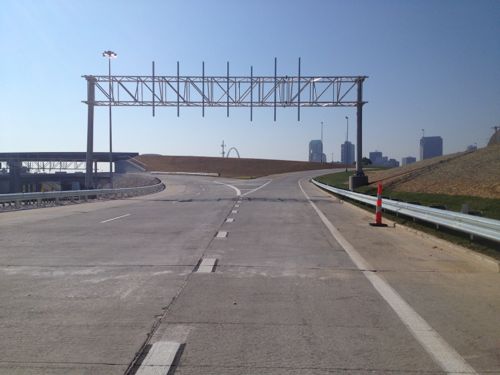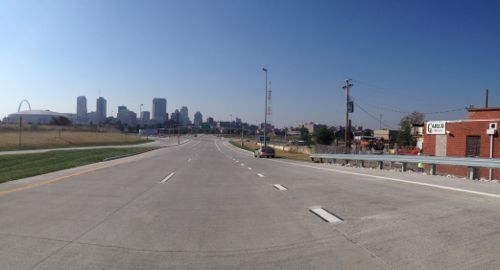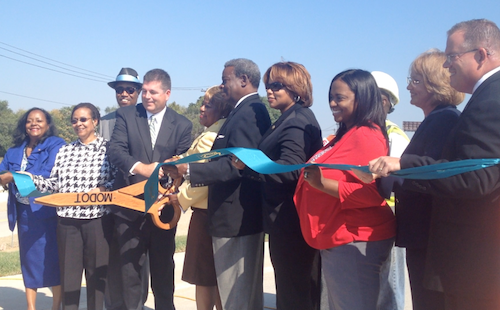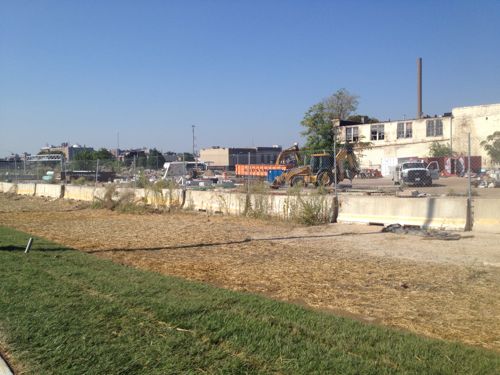Tucker Offramp Now Open, Adjacent Land More Valuable
Yesterday MoDOT and city officials cut a ribbon to open traffic from I-70 onto the new Tucker.




With the new offramp, and the opening of the Stan Musial Veterans Memorial Bridge in 2014, the adjacent land is suddenly prime real estate. Will it be developed like most highway offramp areas or will it be more urban/dense/walkable? I don’t have any illusions the city will make any such demands so my only hope is Paul McKee comes through with a plan the surprises his many critics.
— Steve Patterson
Maybe a QuikTrip, a fast food restaurant, and an Aldi?
This isn’t the only land that jumped in value and it’s already been bought up by investors. Does anyone remember the bruha over a large lot that some developer purchased for pennies on the dollar from the LDA a few years back? The land sharks have eaten. The question is, did they leave enough scraps for you and I and/or is their greed for profit so great that they will hold the land so tight that no development takes place?
It would have been nice had MODOT or the City acquired all the nearby property in anticipation of this game changing infrastructure investment. Then there could have been a competitive process to sell the land when opened for new development. Instead, we get what the market will provide – the cheapest project with the highest short term profit.
They didn’t need to acquire, the city could’ve done a zoning overlay for the area to set the form & quality desired.
. . . . and waited and waited and waited for the “right” development to come along. I get it, we all want “better”, but it’s the private sector that has the money and it’s the private sector that decides when and where they will spend their money. If it comes down to choosing between two bad choices, I’d rather see auto-centric “crap” than vacant lots on this highly-visible corridor into downtown. At least low-density, inexpensively-constructed “crap” can be easily replaced in the future. Vacant lots, especially those in north city, have a nasty tendency to both remain vacant and to multiply . . . .
Can’t agree with you here, J (and usually I do!).
If the City were to zone this area –or any area, really — for specific form and function, I suspect that it would, for the most part, achieve that form and that function…within an acceptable timeframe too.
If the complaint is that this tract will be developed at the “lowest” (read: ugliest, cheapest, autocentric, non-urban/walkable/etc.) use, then I’d argue that’s because our zoning allows for that lowest use. However, if the lowest use allowable is, say, 3-6 story pedestrian-centered mixed use buildings with storefront commercial and office/residential above, then developers will develop for that lowest use. Water runs to the low point, if you will.
Also, developers and businesses can be secure in their efforts to build or open because the zoning prevents that bottom-rung construction that cheapens or hurts the long-term viability of the area.
Have to disagree. While zoning obviously sets a floor. the “market” also sets a threshold, as well. If zoning says “say, 3-6 story pedestrian-centered mixed use buildings with storefront commercial and office/residential above,” and there is currently no market for this kind of product (too expensive to build, rents perceived to be too high for the area, no track record of success in the area), then whoever owns the land will either sit and wait for demand to catch up with what zoning may allow OR they will go to the Board of Aldermen to downgrade the zoning to something that more closely matches the market, say fast food and min-marts, to build something now. It may not be right or great planning, but money talks, especially in a city desperate to maintain a positive revenue stream.
Maybe I should have added “realistic results” somewhere in there.
Yes, if you over-zone an area that can’t/won’t support that coding, then you’ll sit on empty land for a long while. In this case, however, a code which bottoms out at (again, just a suggestion) “say, 3-6 story pedestrian-centered mixed use buildings with storefront commercial and office/residential above” or something of that ilk isn’t that unreasonable to expect.
And if that semi-small form/function can’t be done a mere six blocks from your downtown core — if a clean slate that close to the city center can’t confidently aspire to more than concrete pours, drive-thrus and single-story, single-use offices — well, then we’re in deep trouble.
At the very least, this area needs a strong base-level code from which developers can confidently proceed in their financing, tenant development and construction. I don’t think a ceiling is required because you are right — the market’s not there for something massive anyway (but who knows?!).
I believe a well planned community vision for an area along with government investment in infrastructure will spur economic development. Many saw loft potential downtown but it wasn’t until the Dpwntown Now plan and the rebuild of Washington Ave that things began to happen. Had we waited on the free market we’d be debating tearing down vacant warehouses rather than dealing with the popularity of the area on weekends.
My understanding is that Historic Tax Credits played the biggest role in the success of downtown’s loft developments.
The tax credits came online at the same time as the plan and new streetscape. Any one without the others probably wouldn’t have worked — the plan & streetscape helped create the market and the tax credits made the numbers work.
True enough but there always have to be a demand for such things before the tax credits. Here we are now years later with the threats to cut one of the most successful tax credit programs. I would rather have tax credits for historic renovation over tax credits for Wally Worlds.
I am happy that this land is more valuable. I hope there is NO nasty capitalistic fast food “restaurant placed there.” There should seriously be a ban on fast-food in St. Louis (ok being a bit facetious–but just a bit.) Well I do hope that any building built on this land is stylish and perhaps even built to look like they were before the modernistic period of architecture took over.
Modernism stripped buildings of their character and meaning. Social housing projects using the new “style” emphasizing function over form failed miserably (probably, in part, because the function they were pushing for was engineered and unnatural for human beings). Now we have people attempting to copy and paste history and meaning onto new buildings, and that never quite works. There was a reason for EVERY little detail in a medieval cathedral. Much of the ornamentation was intended SPECIFICALLY for the poor and illiterate, so they could learn in a visual way even if they couldn’t understand the words.
I hope and I really hope that the new buildings built here will be state-of-the-art architecture or at least in keeping with the historical area. Details are important.
*either made to look historical from St. Louis grand turn-of-the-century architecture or something contemporary, grandiose, and beautiful that is a state-of-the-art masterpiece of engineering. But please NO MORE CRAP IN OUR CITY. NO MORE CAPITALISTIC FAST FOOD FAT PEOPLE PLACES TO EAT. ENOUGH FAT UNEDUCATED ASSES IN OUR CITY. GET OUT!!!
Given your simultaneous distaste for capitalism and functional architecture, I take it you have never been to the former Soviet Union, otherwise you would have had some illusions shattered.
Actually I have thank you very much. Capitalism, Communism, and functional architecture all go hand in hand.
Lots of room for parking lots
This may be the very first situation in north St. Louis, or maybe all St. Louis city, where shiny new asphalt, curb, and gutter infrastructure preceded development in a suburban sprawl, infrastructure subsidized driven new growth area in what, fifty years? Interesting juxtaposition from a planning and urbanist perspective.
Expect there to be lots of blog posts and comments complaining about what the future of this area becomes rather than engaged, community involvement on the front end of this rare new opportunity. Stay classy, St. Louis!
The biggest “community involvement” needs to be people willing to write the checks needed to build the stuff that the “community” wants. And, is the “community” the current neighbors, the future neighbors, the commuters who will be passing by every day, tourists, truck drivers making deliveries in the area, former residents or intellectual experts who live miles away and just know, in their hearts and minds, what’s best for the area?! Money talks and people vote every day, making choices in where they will live, work and shop. St. Louis is blessed with many choices and many opportunities – old “urban” buildings, newer “suburban” buildings, autocentric “crap” and new copies and mashups of all-of-the-above. The “right answers”, the most-popular choices survive and thrive; the “wrong answers”, the least-popular choices decline and fail. Urban living is messy – we are never, ever, going to agree, completely, on any one, “right” answer. The best we can hope for is that people will want to be here, clamoring to be here, willing to make sacrifices to be here. Density is a choice, just like living in sprawl is a choice. Nobody is holding a gun to someone’s head and saying you HAVE to live in St. Peters – those people are all choosing to live in their definition of a “good” community.
Telling people what they “want” rarely works – we need to be convinced and cajoled into believing in something. Zoning is not a good tool for convincing people – its primary purpose is to manage the chaos. If you want to convince people that “more-urban” solutions are better, the best (and only) way to do so is to build some and see that they actually work, in St. Louis – that people will actually shop there, live there and/or choose to work there! Developers are greedy SOB’s – if they think can make money, they’re going to build it. Zoning is only a minor hindrance – it can and will be changed (see multiple examples of old neighborhoods rezoned for new retail developments, see an entire city decimated to build a new runway for Lambert). We need successful projects, we need early adopters, we need scarcity – we need a reason to build better, not just complex rules, trying to shape an artificial outcome.
A lot of the property is occupied with unattractive uses such as freight lots, etc. but they do have value. Question is, is it really economically viable to buy out these properties and replace them with fast food joints? Economic reality regardless of zoning could help ensure that future redevelopment results in higher uses. Also, my understanding is that a large amount of the vacant properties are owned by McKee, who has identified this area as Section B with higher uses for the interchange/Tucker St… not as office intensive as his vision for the 22nd St. Interchange with tower(s), etc. but intended as an attractive corridor.